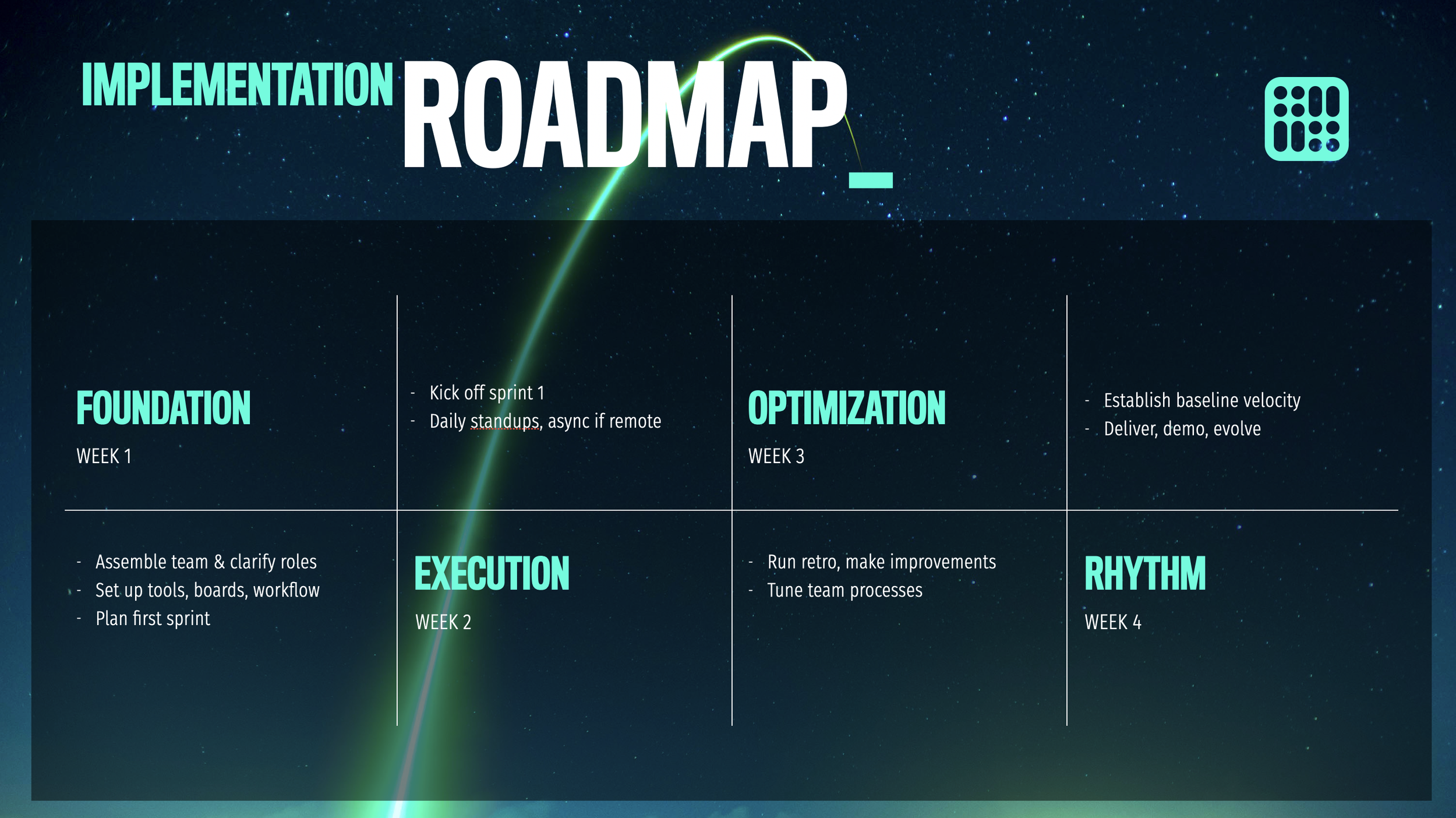SCRUM. Set up right.
How to Launch an Agile Team That Actually Delivers
QUICK TEAM READINESS AUDIT
Rate your team from 0-5 on each category.
Why 90% of Agile Teams Fail in Month 1
(And How to Be in the 10% That Scale)
The difference isn't talent or tools. It's setup.
Most teams rush to "just start building" and skip the precision, clarity, and cadence that separate high-output squads from chaotic sprints.
At THE 8800, we've launched 200+ agile teams using our proven framework. This is the exact checklist we use internally—and with every partner—to go live at full velocity, not just full headcount.
RESULTS FROM PROPER SETUP:
2.3x faster time-to-first-release
67% fewer scope changes mid-sprint
45% higher team satisfaction scores
89% on-time delivery rate (Based on 200+ team launches at THE 8800)
1. Assemble a Balanced Scrum Team
Core Roles to Lock:
Product Owner / Proxy PO
Product Designer
Frontend + Backend Developers
QA / Test Automation
Scrum Master or PM (optionally hybrid)
DevOps / Infrastructure (as needed)
Pro tip: Use Virtual Scrum Teams to gain flexibility and outcome-based velocity without hiring overhead.
2. Define Product Direction and Sprint North Star
Every team needs a compass, not just a backlog.
Define Clearly:
Problem statement - What are we solving?
Primary personas - Who are we building for?
Business goals - Monthly/quarterly targets
Success metrics - How do we measure impact?
Bonus: Co-create a Lean Value Tree to connect quarterly goals to sprint objectives.
3. Establish a Tiered Backlog Strategy
Your backlog isn't just a to-do list—it's your source of truth.
We recommend a tiered grooming model:
Backlog grooming should happen weekly, synced with story mapping and UX validation.
4. Follow a Real Meeting Cadence
THE 8800-Recommended Cadence:
Daily Standups (15 mins, async-friendly if remote)
Weekly Planning (sprint planning, backlog grooming, design sync)
Bi-weekly Sprint Demos (stakeholder feedback loop)
Bi-weekly Retros (team improvement loop)
Monthly Strategy Sync (roadmap vs. progress review)
Quarterly Planning Jam (prioritize epics, reset context, re-align OKRs)
THE 8800 SECRET: The "Demo Prep" Rule
Every story must be demo-ready by Thursday.
This forces: • Real definition of done • Stakeholder-friendly thinking
• Continuous integration mindset
This is where velocity becomes repeatable. Good product teams build. Great ones build in rhythm.
5. Lock In Tools and Workflow Infrastructure
TOOL STACK RECOMMENDATIONS:
Starter Stack (<10 people): ✅ Linear + GitHub + Slack + Figma
Scale Stack (10-50 people): ✅ Jira + GitLab + Slack + Figma + DataDog
Enterprise Stack (50+ people): ✅ Jira + GitHub Enterprise + Teams + Figma + Full observability
Essential Infrastructure:
✅ GitHub/GitLab + PR policies
✅ Jira/Linear/Notion for backlog + boards
✅ Slack + team channels
✅ CI/CD pipelines (with staging + rollback)
✅ Figma + design tokens/system
✅ Component libraries
✅ Post-deploy tracking: Mixpanel, Sentry, Hotjar, etc.
At THE 8800, we bring plug-and-play infrastructure and our Alpine Code frameworks to accelerate setup.
6. Enable Dual Track Execution
We don't believe in design handoffs. We believe in dual-track agility—where discovery and delivery run in parallel.
This is where your team stops building "the wrong thing faster" and starts delivering value weekly.
7. Create Shared Language & Operating Agreements
Before sprint 1, align on:
"Definition of Done" - What constitutes completed work?
What counts as "Blocked" - When to escalate vs. work around
Story point system (if using) - Consistent estimation approach
Sprint goals format - How to communicate objectives
Release plan cadence - Deployment rhythm and approval process
Communication standards - When to async, when to meet
This is culture-by-design, not culture-by-default.
SETUP MISTAKES WE SEE CONSTANTLY
❌ Starting sprints before defining "done"
❌ Skipping the product owner training
❌ No clear escalation path for blockers
❌ Missing DevOps until deployment day
❌ Treating scrum ceremonies as "optional"
❌ No feedback loop with actual users
❌ Forgetting to define team communication standards
SETUP INVESTMENT vs. RETURN
Time invested in setup: 1-2 weeks
Velocity improvement: 2-3x by month 3
Cost of poor setup: 6-8 weeks of rework
ROI: Every day spent in proper setup saves 3-4 days of rework later.
RECAP: Scrum Team Setup Checklist
✅ Team Roles – Cross-functional, agile-native
✅ Product Direction – Problem, users, roadmap
✅ Tiered Backlog Strategy – From roadmap to sprint
✅ Meeting Cadence – Daily, weekly, monthly, quarterly
✅ Workflow Infrastructure – Tools, pipelines, tracking
✅ Dual Track Execution – Design + delivery sync
✅ Shared Language – Clarity = velocity
Final Thought: Setup Isn't Overhead. It's Leverage.
A fast team without setup will still trip on friction.
A well-setup team? They don't just ship—they evolve.
At THE 8800, we bring pre-wired teams, proven frameworks, and sprint-level delivery clarity from day one.
READY TO IMPLEMENT?
Option 1: DIY with this checklist (free)
Option 2: 30-min setup consultation (free)
Option 3: We set up your entire team (investment)
Most teams choose Option 2 → Book your call
Already convinced? → Explore Virtual Scrum Teams
Want to see it in action? → View our Dual Track Process
USED BY 200+ TEAMS INCLUDING:
"Reduced our time-to-market by 60%" - CTO, FinTech Startup
"Finally have predictable delivery" - Product Lead, E-commerce
"Best setup process we've ever used" - Engineering Director, SaaS
Ready to turn your team setup into a competitive advantage?













